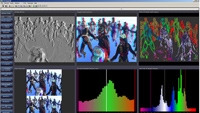CEL-Soft shows stereoscopic analyzer

At IBC2010, Cel-Soft, a recently formed company specializing in broadcast-quality control and measurement technology, introduced the Cel-Scope3D stereoscopic analyzer, a software solution to the challenges of 3-D quality control and depth budget management.
Robin Palmer, managing director of Cel-Soft (who also founded CEL-Broadcast in the early 1980s), said the increased interest in stereoscopic 3-D production has created a need for a tool “precisely tailored to checking depth budget and all possible disparities between the left and right images."
“Pairing two television cameras to operate in 3-D is easy, but even slight differences in terms of physical alignment, optical and electronic performance, can seriously degrade the resultant 3-D illusion,” he said. “Poorly configured 3-D causes eye strain and headaches or, for some viewers, destroys the 3-D effect entirely. This applies to high-end rigs just as much as to semi-pro and industrial equipment.”
To solve this, Cel-Soft said it has harnessed the power of multicore processors and graphics cards while providing real-time measurement of 3-D stereo disparities in HD.
Compatible with all current versions of Microsoft Windows, Cel-Scope3D allows stereoscopic camera alignment to be performed quickly, so the 3-D imagery is accurate from the moment of capture. Running on a PC platform, Cel-Scope3D can display left and right channels simultaneously plus actual depth dynamics. Its display window can each be set to show the usual waveform, vectorscope and histogram graphics as well as differences in video parameters between each channel. Geometry issues can be easily identified using built-in, real-time image manipulation. Quality control tests can be performed on live stereoscopic video sources in any SD, HD or 2K format from common video capture cards or FireWire inputs (or alternatively from file playback).
Cel-Scope3D is designed for use both onset with live inputs and in post production, reviewing and playing back 3-D media files. Captured footage or edits in a wide range of file formats can be viewed and assessed in real time. Disparities are analyzed and displayed as clear and intelligible graphics on 2-D or 3-D monitors. Anaglyph display, touch-screen control and auto-alarm are all supported. Displays can be scaled and arranged as six or eight windows on one or two PC monitors as well as on a 3-D monitor. And an optional 3-D recording capability allows dual stream 3-D content be captured directly to a hard disk in a number of alternative formats.
The professional video industry's #1 source for news, trends and product and tech information. Sign up below.
